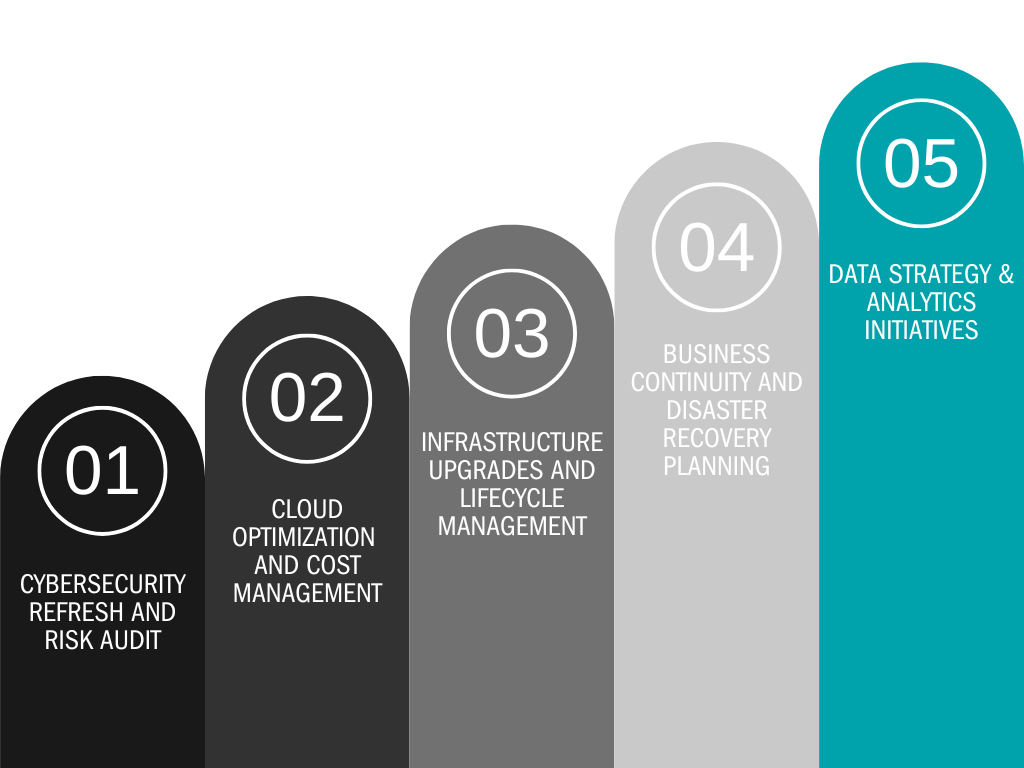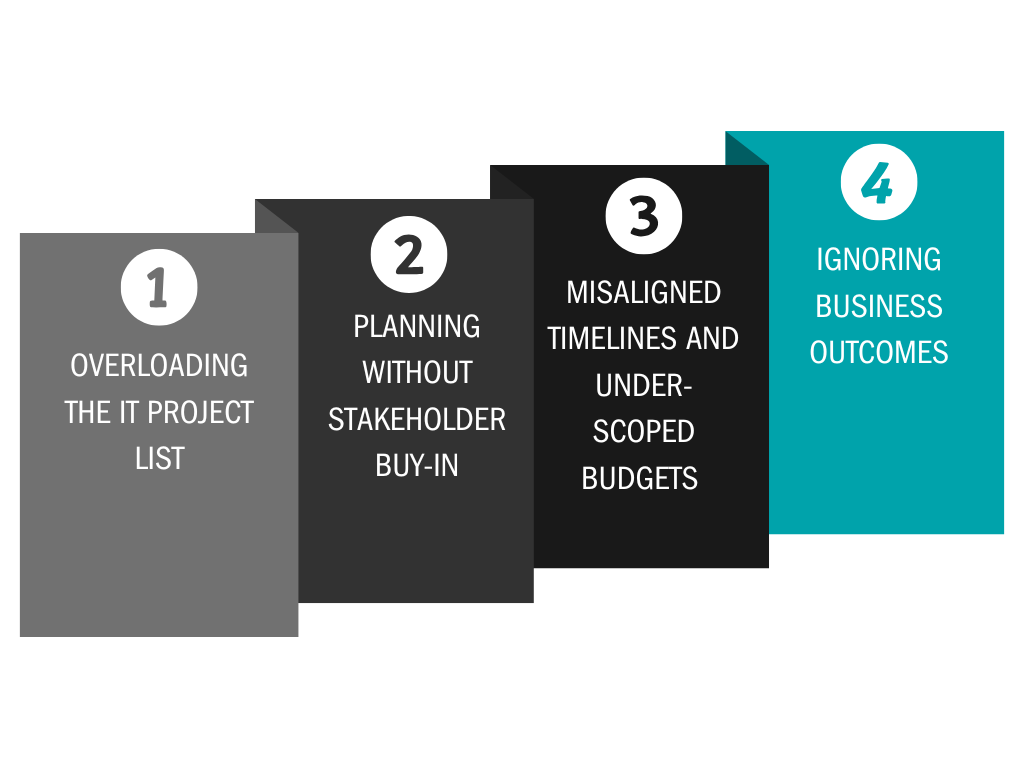June hits, and suddenly, the clock starts ticking faster. Budgets are halfway spent. Strategic goals are either on track or dangerously drifting. And IT teams? Often stuck juggling urgent fixes instead of forward-thinking priorities.
That’s why mid-year IT planning isn’t just a calendar check-in; it’s a strategic pivot point. It gives businesses the chance to realign technology initiatives with evolving goals, fix what’s not working, and double down on what is. Done well; it turns Q3 into a springboard for innovation and momentum.
But too often, companies fall into the trap of “business as usual.” Important IT projects get sidelined. Outdated infrastructure stays patched but not improved. Opportunities for growth are missed; not because the tech isn’t available, but because the roadmap is not clear.
We’ve seen this firsthand. Working with clients across industries, thirtyone3 technology has helped organizations transform mid-year slowdowns into acceleration points. The difference? A tailored approach that ties tech priorities directly to business impact, backed by real-time insights and measurable execution.
- 1. Why Mid-Year IT Planning Matters More Than You Think
- 2. Top IT Projects Businesses Should Prioritize in Q3
- 3. Aligning IT Projects with Business Objectives
- 4. Common Pitfalls and How to Avoid Them
- 5. Finish Strong with Strategic Mid-Year Planning
- 6. Need Help Getting Started?
- 7. Further Reading
- 8. Related Articles
Why Mid-Year IT Planning Matters More Than You Think
For many organizations, Q1 and Q2 are about setting direction and gaining momentum. But by the time Q3 rolls around, that momentum can start to drift; especially if IT teams are focused on outdated priorities or reacting to emerging issues without a strategic lens.
Mid-year IT planning offers a chance to hit pause, evaluate, and make purposeful adjustments. It’s not just about updating task lists or reallocating budgets; it’s about asking the bigger question:
Are our technology initiatives still aligned with our business goals for the year?
This is especially critical in today’s environment, where the pace of change in business technology is relentless. Whether you’re dealing with rising cybersecurity threats, unexpected cloud costs, or lagging infrastructure performance, the ability to reassess and refocus in Q3 can determine how you close out the year.
Here’s where strategic tech planning really pays off:
- Business agility: Adjust quickly to new opportunities or risks.
- Resource optimization: Ensure teams are focused on high-impact work.
- Stronger ROI: Avoid tech investments that no longer align with current business conditions.
- C-suite alignment: Reconnect technology goals with executive-level strategy.
Skipping this mid-year checkpoint often leads to missed targets or last-minute scrambles in Q4. But organizations that plan deliberately in Q3 are more likely to finish the year strong (with fewer surprises and more measurable wins).
Top IT Projects Businesses Should Prioritize in Q3
When it comes to IT planning, the third quarter presents a unique opportunity. You’re far enough into the year to assess performance, but there’s still time to pivot and deliver meaningful outcomes. To make the most of it, leaders should focus their IT project list on high-impact initiatives that tighten security, improve efficiency, and prepare systems for future growth.
Below are the top IT priorities businesses should be evaluating and executing as summer sets in.

1. Cybersecurity Refresh and Risk Audit
Cyber threats don’t follow a calendar, but Q3 is the perfect time to refresh your security posture. As technology stacks evolve, so do vulnerabilities, especially after implementing changes earlier in the year.
A mid-year cybersecurity review should include:
- Penetration testing to identify gaps
- Policy reviews to reflect new workflows or regulations
- Employee training refreshers on phishing and access protocols
- Third-party vendor risk assessments
According to Forrester’s 2025 cybersecurity predictions, rising regulatory scrutiny will push businesses to take a more proactive security stance. Waiting until Q4 may be too late to catch risks or prepare for compliance audits.
2. Cloud Optimization and Cost Management
Cloud infrastructure costs could creep up quietly, especially if assets deployed earlier in the year are underutilized or duplicated. Q3 is ideal for a deep dive into your cloud environment to:
- Identify “zombie” instances draining budget
- Consolidate underused services
- Apply automation to scale infrastructure dynamically
- Evaluate cost-performance trade-offs across providers
Cloud optimization is about improving performance and planning for Q4 scalability with confidence.
3. Infrastructure Upgrades and Lifecycle Management
Outdated hardware or aging systems often become invisible roadblocks, until something breaks down. Use Q3 to revisit your infrastructure lifecycle plan:
- Schedule necessary replacements before year-end freeze periods
- Allocate budget to cover hardware and labor
- Reduce downtime risk by spreading upgrade windows
Aligning your infrastructure roadmap with broader digital initiatives ensures that your team isn’t held back by technology that’s no longer serving its purpose.
4. Business Continuity and Disaster Recovery Planning
With the growing frequency of outages, cyber incidents, and supply chain disruptions, disaster recovery plans can’t be static. Q3 is a chance to revisit your DR/BCP documentation and perform real-world testing based on what changed in the first half of the year.
Many organizations overlook critical steps in this process, which can lead to significant downtime or data loss during an actual event. To avoid these pitfalls, it’s important to understand the most common business continuity planning mistakes and how to prevent them. From inadequate testing to unclear ownership, these missteps can derail even the best-laid plans.
5. Data Strategy & Analytics Initiatives
Do you want a stronger finish in Q4? Your KPIs need to be measurable and visible. Q3 is a critical time to:
- Audit data pipelines and quality
- Build or refine dashboards tied to strategic objectives
- Improve forecasting with analytics or AI
An agile, data-driven business can make faster and smarter decisions, especially when the stakes rise later in the year.

Aligning IT Projects with Business Objectives
Strong execution starts with strategic alignment. Yet, one of the most common breakdowns in IT planning is the disconnect between technical initiatives and actual business goals. IT teams might be optimizing systems or deploying tools. If those efforts don’t directly support what the business is trying to achieve, the value gets lost in translation.
Q3 is the perfect time to close that gap.
Start with the “Why” Behind Each Project
Before adding another item to your IT project list, step back and ask:
- What business challenge does this solve?
- How does it support our revenue, customer experience, compliance, or operational goals?
- What metrics will we use to evaluate its success?
Projects that lack these answers may not deserve a top spot on your Q3 roadmap.
Bridge the Gap Between IT and the C-Suite
This is where alignment becomes a leadership issue. IT decision-makers need to communicate in business language (outcomes, not configurations). Involving executive leadership in Q3 planning conversations ensures initiatives are not only well-funded but well-understood.
Use Proven Prioritization Frameworks
To narrow down high-priority efforts, consider applying decision-making tools such as:
- MoSCoW method (Must have, Should have, Could have, Won’t have)
- Eisenhower Matrix (Urgent vs. Important)
- Weighted Scoring Models based on business impact, risk, and resource requirements
These methods help teams focus on what drives results, not just what’s easy to check off a list.
Anchor Your Tech Strategy in Industry Trends
It’s also essential to zoom out. Strategic planning in Q3 isn’t just about catching up; it’s about looking ahead. Aligning your efforts with emerging technology trends shaping the future of business can give your IT investments more longevity and impact.
From AI-enhanced development to industry-specific cloud platforms, these forward-looking priorities are reshaping how organizations drive innovation and agility. By syncing current initiatives with where the market is heading, you’re not just solving today’s problems; you’re setting your organization up for long-term success.
Common Pitfalls and How to Avoid Them
Even with the best intentions, many organizations fall into the same traps when executing their mid-year IT planning. These missteps don’t just stall progress; they also waste resources, strain teams, and prevent strategic initiatives from gaining traction when they’re needed most.
Let’s look at a few of the most common mistakes and how to avoid them.

1. Overloading the IT Project List
It’s tempting to cram Q3 full of every initiative that’s been waiting for attention. But an overcrowded roadmap leads to diluted focus and mediocre execution. Teams burn out, priorities blur, and critical tasks get lost in the noise.
Avoid it by: Prioritizing ruthlessly. Use frameworks like MoSCoW or weighted scoring to determine what truly deserves time, budget, and attention in the back half of the year.
2. Planning Without Stakeholder Buy-In
IT leaders often scope, and schedule projects based on technical needs without fully involving business stakeholders. The result? Projects get blocked by red tape, delayed due to lack of executive support, or reworked midstream to align with misunderstood goals.
Avoid it by: Making planning a collaborative process. Involve department heads, end-users, and executive sponsors early to ensure alignment and accelerate decision-making.
3. Misaligned Timelines and Under-Scoped Budgets
A project may look good on paper, but without realistic timelines or accurate budget forecasting, it’s likely to stall (or fail entirely). This is especially risky in Q3, where any slippage can push deadlines dangerously close to year-end blackout periods.
Avoid it by: Scoping conservatively. Build in buffer time for approvals, testing, and rollout. Confirm that your budget accounts for licensing, labor, and unexpected contingencies.
4. Ignoring Business Outcomes
A project may look good on paper, but without realistic timelines or accurate budget forecasting, it’s likely to stall (or fail entirely). This is especially risky in Q3, where any slippage can push deadlines dangerously close to year-end blackout periods.
Avoid it by: Scoping conservatively. Build in buffer time for approvals, testing, and rollout. Confirm that your budget accounts for licensing, labor, and unexpected contingencies.
How thirtyone3 technology Helps Teams Finish the Year Strong
Mid-year planning succeeds when the right projects are paired with precise execution: delivered with clarity, urgency, and strategic focus. That’s where our team steps in.
thirtyone3 helps organizations break through planning paralysis and translate strategy into action. Whether you’re assessing which initiatives to prioritize or struggling to align your IT planning with evolving business goals, we bring structure, insight, and executional horsepower to every phase of your Q3 roadmap.
Our approach is simple but effective:
- Clarity-first assessments: We help you evaluate your current state, identify hidden risks, and define what “done” looks like for each initiative.
- Alignment workshops: Our consultants facilitate cross-functional planning sessions to ensure IT projects are directly tied to business objectives.
- Executional support: From deploying cybersecurity upgrades to managing infrastructure lifecycles, we work as an extension of your team; keeping timelines tight and goals on track.
We’ve partnered with companies across industries to turn uncertain mid-year moments into focused transformation efforts. In one case, a healthcare client used our roadmap process to consolidate infrastructure, reduce cloud costs by 28%, and close out the year with zero unplanned outages. That’s the power of focused, intentional tech planning.
Finish Strong with Strategic Mid-Year Planning
The second half of the year is a critical window. It’s where execution sharpens, goals get realigned, and missed opportunities from Q1 and Q2 can still be reclaimed; if you have the right plan in place.
IT planning in Q3 isn’t reactive cleanup; it’s a forward-looking strategy to finish with momentum. By focusing on high-impact IT projects, eliminating roadblocks, and aligning initiatives with clear business goals, organizations can not only stabilize operations but also drive meaningful growth before year-end.
Whether it’s strengthening your cybersecurity posture, optimizing cloud costs, or ensuring your infrastructure is ready for what’s next, the time to act is now. Because come Q4, it’s no longer about planning, it’s about delivering.
If your team is ready to make the most of the next few months, we’re here to help. At thirtyone3 technology, we bring the structure, clarity, and strategic execution to ensure your IT priorities align with your bottom line (so you can finish the year strong and start the next one even stronger!).
Need Help Getting Started?
Further Reading
Gartner: Top Strategic Technology Trends for 2025
This report outlines the most impactful technology trends shaping the future of IT strategy, including AI-driven development, platform engineering, and sustainable tech investment strategies.
Forrester: Predictions 2025: Security and Risk
Forrester’s forward-looking analysis on cybersecurity, risk posture, and regulatory evolution provides critical context for Q3 planning in a threat-heavy digital landscape.
thirtyone3 technology: Top Business Continuity Planning Errors and How to Avoid Them
This guide offers actionable insight into the most common continuity planning mistakes businesses make along with strategies to build more resilient IT operations.

